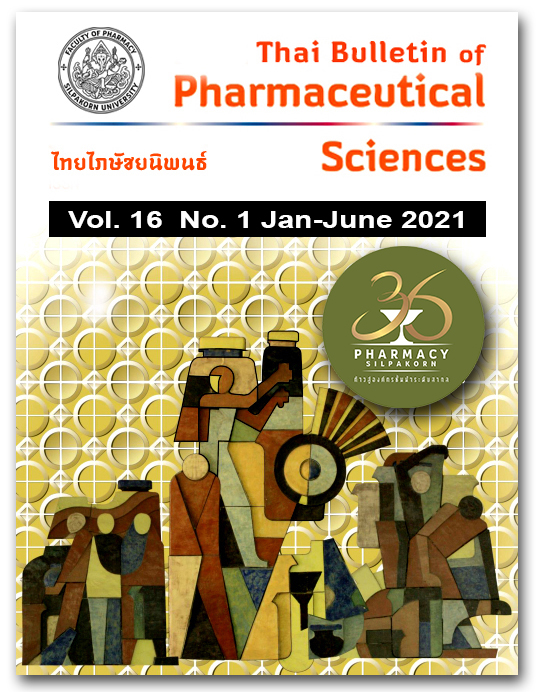POPULATION PHARMACOKINETICS OF TACROLIMUS IN THAI LIVER TRANSPLANT PATIENTS
DOI:
https://doi.org/10.69598/tbps.16.1.17-30Keywords:
population pharmacokinetics, tacrolimus, liver transplant patientsAbstract
Tacrolimus is a highly effective immunosuppressant but has a narrow therapeutic index with high pharmacokinetic variability. This study aimed to characterize the population pharmacokinetics of tacrolimus and to explore clinical factors that could explain the pharmacokinetic variability of tacrolimus during the 8th day to the 6th month after liver transplantation. A total of 1,012 tacrolimus concentration-time measurements from 50 recipients receiving oral immediate-release tacrolimus were analyzed by nonlinear mixed effects approach using NONMEM. In addition, thirteen clinical covariates including body weight, hemoglobin (HB), hematocrit (HCT), liver function tests (AST, ALT, ALP, GGT, TB, DB), renal function tests (BUN, SCr), albumin and a number of post-operative days were tested to explore their influential effects on the pharmacokinetic variability. It was found that pharmacokinetic properties of tacrolimus were best described by a one-compartment model with first order absorption and elimination. HB and total bilirubin (TB) significantly affected the oral clearance (CL/F) of tacrolimus. Increased levels of HB or TB would result in a decrease in the CL/F of tacrolimus as indicated in the following equation. CL/F = 26.2 x (HB/11)–0.802 x (TB/1.9)–0.096 L/h. None of the tested clinical factors were found to significantly influence the apparent volume of distribution of tacrolimus. This finding suggests that HB and TB are significant factors influencing the CL/F of tacrolimus in Thai liver transplant patients. Therefore, these two clinical factors should be considered in determining the tacrolimus dosage during the first 6 months’ post-transplantation.
References
Nivatvongs S, Sirichindakul B, Nontasuti B, Kongkam P, Rerknimitr R, Kullavanijaya P. Result of orthotopic liver transplantation at King Chulalongkorn Memorial Hospital: the first series from Thailand. J Med Assoc Thai. 2003;86 Suppl 2:S445-50
The Thai Red Cross Organ Donation Centre. Annual report 2019 [Internet]. Bangkok: The Centre; 2019 [cited 2020 May 1]. Available from: https://www.organdonate.in.th/assets/files/odc2562.pdf (in Thai)
European Association for the Study of the Liver. EASL clinical practice guidelines: liver transplantation. J Hepatol. 2016;64:433-85.
Thai Transplantation Society. Thai transplant care (TTC) liver [Internet]. Bangkok: The Society; 2015 [cited 2020 May 1]. Available from: http://www.transplantthai.org/upload/170815114538293_MNB.pdf (in Thai)
McAlister VC, Haddad E, Renouf E, Malthaner RA, Kjaer MS, Gluud LL. Cyclosporin versus tacrolimus as primary immunosuppressant after liver transplantation: a meta-analysis. Am J Transplant. 2006;6:1578-85.
Muduma G, Saunders R, Odeyemi I, Pollock RF. Systematic review and meta-analysis of tacrolimus versus ciclosporin as primary immunosuppression after liver transplant. PLoS One. 2016;11(11):e0160421.
Ringe B, Braun F, Schütz E, Ramadori G, Oellerich M. Therapeutic window of tacrolimus in liver transplantation. Ther drug monit. 1999;21(4):438.
Zhang Y, Yang JW, Zhu LQ, Wang N. Effects on pharmacokinetics of tacrolimus in liver transplant patients. SM J Pharmac Ther. 2016;2(2):1012.
Rayar M, Tron C, Jezequel C, Beaurepaire JM, Petitcollin A, Houssel-Debry P, et al. High intrapatient variability of tacrolimus exposure in the early period after liver transplantation is associated with poorer outcomes. Transplant. 2018;102(3):e108-14.
U.S. Food and Drug Administration. Population pharmacokinetics: guidance for industry (draft guidance; July 2019) [Internet]. Silver Spring (MD): FDA; 2019 [cited 2020 May 1]. Available from: https://www.fda.gov/media/128793/download
Boeckmann AJ, Sheiner LB, Beal SL. NONMEM users guide - part V: introductory guide. 2nd ed. San Francisco: NONMEM Project Group, University of California; 2011.
Wallemacq P, Goffinet JS, O'Morchoe S, Rosiere T, Maine GT, Labalette M, et al. Multi-site analytical evaluation of the Abbott ARCHITECT tacrolimus assay. Ther Drug Monit. 2009;31(2):198-204.
Jusko WJ, Piekoszewski W, Klintmalm GB, Shaefer MS, Hebert MF, Piergies AA, et al. Pharmacokinetics of tacrolimus in liver transplant patients. Clin Pharmacol Ther. 1995;57(3):281-90.
Wallemacq P, Armstrong VW, Brunet M, Haufroid V, Holt DW, Johnston A, et al. Opportunities to optimize tacrolimus therapy in solid organ transplantation: report of the European consensus conference. Ther Drug Monit. 2009;31(2):139-52.
Antignac M, Hulot JS, Boleslawski E, Hannoun L, Touitou Y, Farinotti R, et al. Population pharmacokinetics of tacrolimus in full liver transplant patients: modelling of the post-operative clearance. Eur J Clin Pharmacol. 2005;61(5-6):409-16.
Lee JY, Hahn HJ, Son IJ, Suh KS, Yi NJ, Oh JM, et al. Factors affecting the apparent clearance of tacrolimus in Korean adult liver transplant recipients. Pharmacotherapy. 2006;26(8):1069-77.
Li D, Lu W, Zhu JY, Gao J, Lou YQ, Zhang GL. Population pharmacokinetics of tacrolimus and CYP3A5, MDR1 and IL-10 polymorphisms in adult liver transplant patients. J Clin Pharm Ther. 2007;32:505-15.
Beringer PM. Winter's basic clinical pharmacokinetics. 6th ed. Philadelphia: Wolters Kluwer Health; 2018.
Vadcharavivad S, Praisuwan S, Techawathanawanna N, Treyaprasert W, Avihingsanon Y. Population pharmacokinetics of tacrolimus in Thai kidney transplant patients: comparison with similar data from other populations. J Clin Pharm Ther. 2016;41:310-28.
Zhu L, Yang J, Zhang Y, Jing Y, Zhang Y, Li G. Effects of CYP3A5 genotypes, ABCB1 C3435T and G2677T/A polymorphism on pharmacokinetics of tacrolimus in Chinese adult liver transplant patients. Xenobiotica. 2015;45(9):840-6.
Chan S, Burke MT, Johnson DW, Francis RS, Mudge DW. Tacrolimus toxicity due to biliary obstruction in a combined kidney and liver transplant recipient. Case Rep Transplant. 2017;2017:9096435.
Zhu L, Wang H, Sun X, Rao W, Qu W, Zhang Y, et al. The population pharmacokinetic models of tacrolimus in Chinese adult liver transplantation patients. J Pharm (Cairo). 2014;2014:713650.
Lu YX, Su QH, Wu KH, Ren YP, Li L, Zhou TY, et al. A population pharmacokinetic study of tacrolimus in healthy Chinese volunteers and liver transplant patients. Acta Pharmacol Sin. 2015;36(2):281-8.
Downloads
Published
How to Cite
Issue
Section
License
All articles published and information contained in this journal such as text, graphics, logos and images is copyrighted by and proprietary to the Thai Bulletin of Pharmaceutical Sciences, and may not be reproduced in whole or in part by persons, organizations, or corporations other than the Thai Bulletin of Pharmaceutical Sciences and the authors without prior written permission.



